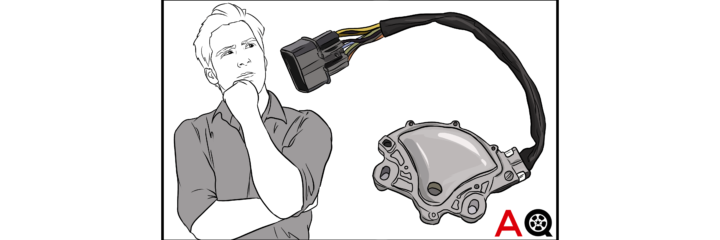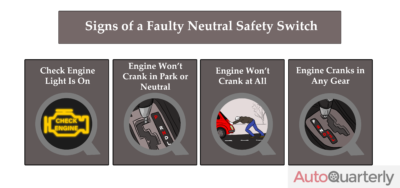A small yet mighty part of your car’s engine, the neutral safety switch serves an important function in keeping your car in place while you start the engine. It was designed with safety in mind and can be potentially hazardous if you find yourself operating a vehicle with a faulty neutral safety switch.
In this article, we will discuss exactly how a neutral safety switch works and why it is important, and go over the signs that may indicate your car is in need of a replacement neutral safety switch. Read on to find out all you need to know about this important car part.
Understanding Neutral Safety Switches
In order to understand the importance of a neutral safety switch, you should first know how it works and its role in the functions of your car. In vehicles with automatic transmissions, the neutral safety switch is found in either the steering column or the transmission selection shaft. The exact area depends on your car’s model, and you can usually find out which your vehicle has by consulting the owner’s manual.
The neutral safety switch comes into play when it is time to start your car; you can only start your car while it is in park or neutral due to this device. If you have accidentally switched to drive or reverse before attempting to start the engine, the neutral safety switch will prevent your car from starting.
Additionally, the neutral safety switch is often attached to the reverse lights of your vehicle. When you start your engine in park or neutral, the switch activates the rear lights, indicating to others around you that your car may be about to move.
Why Is a Neutral Safety Switch Important?
Without a neutral safety switch, your car would be able to start in any gear. This can be very dangerous if you accidentally switch your gears before starting your car, as your car would immediately go forwards or backwards as soon as the engine is running. The switch prevents accidents and allows more peace of mind when it comes to starting your car.
Immediately having your car move upon starting can also be very bad for the starter and transmission of your engine. The neutral safety switch will only allow the electric current to proceed from the engine starter to the ignition switch and system when your car is in park or neutral to reduce any strain and prevent damage to the engine.
What About Cars With a Manual Transmission?
In manual cars, a device similar to the neutral safety switch is located underneath the clutch pedal. It is often called a clutch safety switch and will only allow you to start your car when pressing down on the clutch pedal. It serves the same purpose as the neutral safety switch in automatic vehicles.
Signs of a Faulty Neutral Safety Switch
The neutral safety switch is a very important component of your car, and without it you could experience significant damage to the transmission or engine of your vehicle. Below, we have listed several signs that may indicate you need to replace your neutral safety switch.
Check Engine Light Is On
Some car manufacturers will include the neutral safety switch in your vehicle’s diagnostic circuit. If this is the case, you may see the check engine light illuminated when there is a problem with the switch.
You can take your car to a chain auto parts store to have the codes read and the issue diagnosed, but if it truly is a neutral safety switch issue, you may have trouble getting the car there.
If you notice the check engine light illuminated in addition to any of the other symptoms of a faulty neutral safety switch, it is very likely that it is the culprit to your car problems.
Engine Won’t Crank in Park or Neutral
As soon as you turn the ignition while your car is in park, the engine should begin to crank over. If it doesn’t do this, and instead only cranks in neutral, you may have a faulty switch. However, this issue of not starting while in park could be caused by other issues, which you would need a mechanic to diagnose.
Similarly, if your car is in neutral and refuses to turn over when you attempt to start it, but it will start while in park, the issue is most likely with the neutral safety switch.
Engine Won’t Crank at All
If your engine will not crank over at all, no matter what gear you are in, the cause is likely to be the neutral safety switch. In this case, there is no electrical current reaching the switch causing it to activate the starter and your engine.
Engine Cranks in Any Gear
One of the more dangerous signs your neutral safety switch is faulty is if your engine will turn over in any gear. This means that your vehicle is essentially operating as if it doesn’t have a neutral safety switch, and you are able to crank the engine even if it is already running.
If you are experiencing this symptom, you should be getting your car looked at by a professional as soon as possible to prevent any serious damage to your car, yourself, or your engine.
Ruling Out Other Issues
There are many other issues that could give you problems when trying to start your car, including a bad battery or a faulty alternator. Listen to your car when you try to start it, and if you hear a loud clicking sound, it might be a bad starter; if the engine struggles to turn over but doesn’t make it, it is more likely to be a battery issue.
Additionally, if you are able to start the car, check to see if you can shift gears properly. If not, or if the gear selector feels loose, you may have a problem with the transmission or with the instrument cluster.
In these cases, it is hard to narrow down exactly what is causing your car issues by yourself. The best thing for you to do is get your car to a mechanic as soon, and as safely, as possible for a full diagnostic on your vehicle’s problems.
What Causes Damage to the Neutral Safety Switch?

Like many other car parts, it is common for the neutral safety switch to decrease in function over time; age is a large factor in causing damage to this component. However, environmental issues like dirt, moisture, heat, and corrosion can also contribute to the failure of the switch.
It can be hard to prevent damage to the neutral safety switch, so the best you can do is take good car of your car and perform regular maintenance on it. This way, you can keep your car in good shape as it ages, and hopefully catch any issues before they arise.
Neutral Safety Switch Repair
The location of the neutral safety switch does not make it the easiest car part to replace. It is often located underneath the car, near the transmission, and you might need to have some experience with DIY car repairs in order to confidently replace this part.
It may be easier to take your car to a professional to get this replaced; the cost of such a replacement will typically be around 100 to 350 dollars depending on the make and model of your vehicle and the mechanic’s labor costs.
You can repair the neutral safety switch yourself, which may be a little bit cheaper, but require more knowledge of car repair. Purchasing the part separately will typically cost around 95 to 150 dollars.
You can check out this video for help understanding exactly how to repair this part yourself.
Switch for a Safe Car
The neutral safety switch is an incredibly important part of your car’s safety mechanism. It helps prevent damage to your engine, and stops your car from lurching forward or backward suddenly and potentially causing an accident.
If you suspect your neutral safety switch has stopped working and your car is exhibiting any of the faulty signs we discussed above, it is a good idea to take your car to a professional for a diagnosis as soon as possible.



